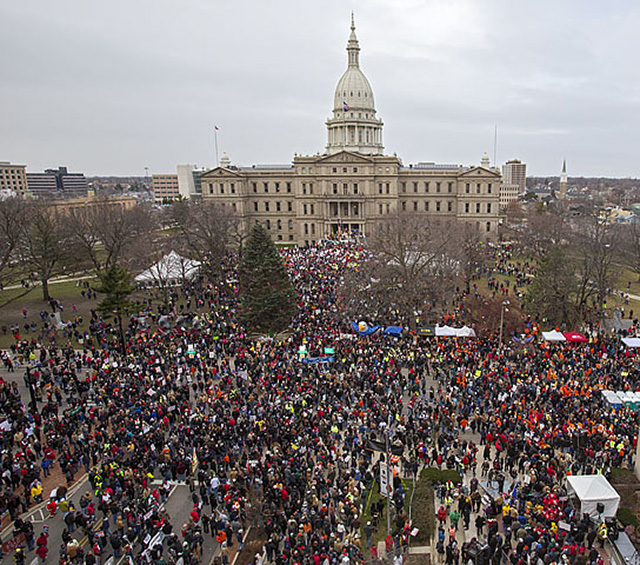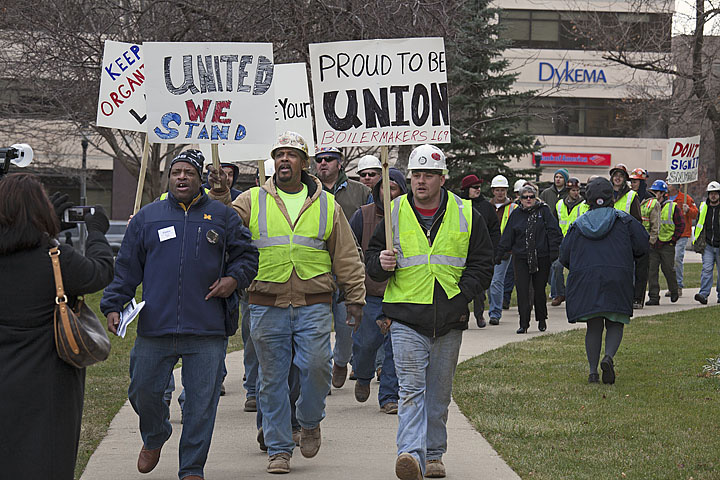 Lansing (December 2012)
Lansing (December 2012)
In what seemed an unthinkable moment to many supporters of organized labor, in 2012 the Michigan legislature – with both chambers having Republican majorities – passed and then-Governor Snyder signed a law, making Michigan the 24th state in the United States to enact so-called Right-to-Work (“RTW”) legislation. In Michigan as elsewhere, RTW means that each employee gets to decide whether or not to pay union dues even if the majority of employees at a workplace have voted to be represented by the union. In effect, it abolishes the so-called “union shop” in which workers must join the union and pay dues and by doing so makes it harder for unions to collect dues. A portion of those dues are used to support unions’ activities in the political arena, generally in favor of Democratic candidates, a fact not lost on Republicans.
One of the opening salvos in the national conservative effort to roll back the New Deal in the years following World War II was the Taft-Hartley Act. Among other things, Section 14(b) of this piece of legislation permitted states to set their own policies regarding whether unions may compel workers to pay dues, rather than establishing a national policy on the matter. RTW took root in anti-union southern states, where wages were generally lower as well. Thus, the stage was set for companies to shutter northern and eastern plants where unions had established roots and open new facilities in states where RTW statutes prevailed. Unions faced long odds in their campaigns to organize runaway plants and the plants of foreign companies that had begun to establish a footprint in the U.S. market and generally preferred RTW states.
The obvious question is how Michigan, the 7th-most-unionized state in the nation and arguably the crucible of American industrial unionism, could have joined the RTW club. This question has been debated by both dismayed union members and supporters as well as by distinguished academic scholars.
The arguments of Michigan State University professor Michele Kaminski, published in 2015 in the Labor Studies Journal, and echoed in a North American Labor History Conference presentation by her colleague John Revitte serve as the foundation for the analysis outlined below. Kaminski and Revitte argue that the following factors are key to understanding what happened in Michigan:
 Lansing (December 2012)
Lansing (December 2012)
1. Republican control of both chambers of the State Legislature made the Party eager to weaken the power of the unions, especially after a Republican was elected governor in 2010. Republican control in Lansing was further cemented by effective gerrymandering: for example, in 2014 Democrats secured 52% of the votes cast for US House members, yet they captured only 36% of the seats.
2. A concerted campaign was orchestrated by billionaire Republican activist and former gubernatorial candidate, Richard DeVos, who had close ties to the organizations that funded elected Republican in the State Legislature and openly threatened to fund a primary opponent against any that voted against RTW.
3. An unusual feature of Michigan state government, called the “lame duck session,” allows the Legislature to convene after the election, but before the retiring or defeated incumbents leave office. An unrelated feature – that laws with a funding appropriation cannot be repealed by referendum – allows legislators to save the most controversial bills, like RTW, for the lame duck session and to embed appropriations in those bills.
4. The labor movement had crafted and backed four of the six ballot proposals that appeared on the 2012 ballot in Michigan. One of these was a proposal to enshrine a broad set collective bargaining rights in the State’s constitution. When polling showed roughly 60% of the public in support, an alarmed state Chamber of Commerce decided to launch a campaign urging voters to say no to all six proposals even though it had previously supported two of them. The collective bargaining proposal went down 57-43%.
The then-governor, former tech executive Rick Snyder, had said that RTW was “not on my agenda.” However, he was reportedly angry that labor leaders had put so much effort into the worker-friendly ballot proposals, which he viewed as an effort to undermine his efforts to make Michigan more “business-friendly.” With the defeat of the collective bargaining proposal and faced with the elected members of his party having voted so overwhelmingly for RTW – with only six of 64 voting “no” in the lame duck session - Snyder decided to sign the legislation.
There is no way to assess whether or not any one of these factors was particularly critical to the passage of RTW. Certainly, but for DeVos’s activism, RTW probably would not have become law in Michigan; but even with DeVos’s efforts, it might never have become law but for the lame duck rules and the Governor’s anger at the labor movement’s electoral activism that year.
 Lansing (December 2012)
Lansing (December 2012)
Even now – years after the vote on RTW – it is not completely clear what effect its passage is having or will have. Some unions have lost fewer than 5% of their former members and the dues they paid, but others have lost several times that percentage. Perhaps the greatest impact has been Republicans may now feel emboldened by RTW’s success to give less weight to the positions and rights of the state’s labor unions and their members. On the other hand, labor’s defeat has led some unions to put renewed effort into more aggressive member representation and into educating members and urging them to get more involved in politics.
The essay that appears above was drafted in the spring of 2020. On March 24, 2023, Michigan became the first state in 58 years to repeal its right-to-work statute.
This opinion posted to the Griot by Daryl Newman, President of the Detroit AFL-CIO and Secretary-Treasurer of the Michigan AFL-CIO, Remembering the Racist History of ‘Right-to-Work’ Laws adds an important perspective to this discussion, grounding it in a broader national context.
RESEARCH & Text - Dan Luria, with Ron Alpern and James Pedersen




